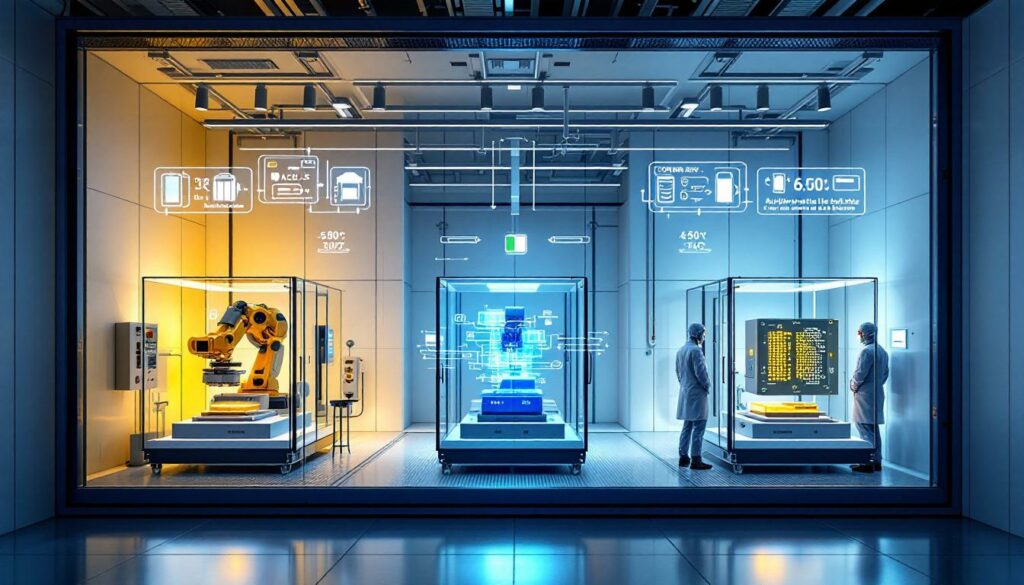What is a Dry Room Laboratory in Battery Manufacturing?
A dry room laboratory represents a highly specialized environment essential for lithium battery production, where humidity levels are maintained at extraordinarily low levels. These controlled atmospheres are critical because moisture exposure can severely compromise both battery performance and safety. Unlike standard manufacturing environments, dry rooms operate with dew points as low as -50°C, ensuring virtually moisture-free conditions.
The significance of these controlled environments cannot be overstated in battery production. When moisture interacts with lithium materials, it can trigger unwanted chemical reactions that degrade battery components. Even minimal humidity exposure can lead to diminished capacity, shortened lifespan, and in extreme cases, safety hazards including thermal runaway scenarios.
Modern dry room laboratories incorporate sophisticated environmental control systems that continuously monitor and adjust conditions. These systems typically include multiple redundant dehumidification units, specialized air handling equipment, and real-time monitoring sensors that maintain precise atmospheric parameters throughout research and manufacturing processes.
Technical Note: Exposure to atmospheric moisture causes lithium materials to form lithium hydroxide compounds that compromise electrochemical performance. Each 1% increase in relative humidity can accelerate degradation rates by 5-10% in sensitive battery components.
Battery manufacturers utilize these facilities throughout the production cycle, from initial material handling to cell assembly and sealing. Research-focused dry rooms allow for experimentation with increasingly sensitive materials like solid-state electrolytes that would be impossible to develop in standard laboratory conditions.
Why Has Comau Invested in a Dry Room Laboratory?
The Strategic Investment Decision
Comau, an industrial automation specialist, has made a significant capital commitment of nearly €1 million to establish a state-of-the-art dry room laboratory at its headquarters in Grugliasco, Italy. This investment reflects a strategic pivot toward vertical integration of research capabilities rather than outsourcing to external facilities.
The decision aligns with the company's long-term vision of becoming a comprehensive solution provider in battery manufacturing. By bringing these specialized capabilities in-house, Comau gains several competitive advantages: accelerated development cycles, protection of proprietary innovations, and reduced dependence on third-party testing facilities that often have lengthy waiting periods and limited customization options.
Industry analysts note that this investment follows a growing trend among automation companies seeking to differentiate themselves in the increasingly competitive battery metals landscape. The return on investment calculation likely factors in both direct cost savings from eliminated external lab fees and the strategic value of faster innovation cycles.
Expanding Battery Technology Expertise
The dry room laboratory significantly enhances Comau's technical capabilities across the battery technology spectrum. With this facility, the company positions itself at the forefront of both current commercial lithium-ion technologies and next-generation battery innovations.
The company has assembled a dedicated team of over 40 specialized engineers at its Global Competence Centre focused on battery technology advancement. This talent concentration represents a substantial human capital investment complementing the physical infrastructure of the dry room.
According to Pietro Gorlier, Comau's CEO, the facility plays a crucial role in the company's broader innovation strategy: "This investment reflects our commitment to advancing industrial innovation while reinforcing investments in Italy and creating opportunities for highly skilled professionals."
Particularly notable is Comau's emphasis on solid-state battery technologies, which promise energy densities up to 80% higher than conventional lithium-ion cells while offering improved safety profiles through the elimination of flammable liquid electrolytes. The dry room provides the necessary environmental conditions to work with the highly moisture-sensitive materials essential to these advanced battery architectures.
What Technical Specifications Does Comau's Dry Room Feature?
Advanced Environmental Control Systems
Comau's dry room laboratory incorporates cutting-edge environmental control technology capable of maintaining extraordinarily low moisture levels. The facility's performance specifications exceed typical industry standards, positioning it among the most capable battery research environments in Europe.
The laboratory houses three distinct proto-test stations with varying environmental capabilities:
- Two stations operating at a dew point of -40°C (equivalent to less than 1% relative humidity)
- One advanced station achieving an even more stringent -50°C dew point (approximately 0.1% relative humidity)
These ultra-low humidity levels are maintained through a complex system of specialized dehumidification equipment, precision-controlled air handling units, and continuous monitoring systems. The -50°C dew point capability is particularly significant as it enables work with the most moisture-sensitive materials used in next-generation revolutionary lithium batteries.
The facility's environmental control system includes:
- Multi-stage desiccant dehumidification units
- Temperature-controlled air circulation systems
- Redundant moisture monitoring sensors
- Specialized airlock entry systems to prevent humidity infiltration
- Energy recovery systems to manage the considerable power requirements
Specialized Automation Equipment
Beyond environmental controls, the dry room is equipped with purpose-built automation technology designed specifically for sensitive battery manufacturing environments. This equipment enables precise handling and testing of moisture-sensitive materials without compromise.
At the center of the automation suite is the Comau Racer 5 Sensitive Environments robot, engineered specifically for operation in controlled atmospheric conditions. Unlike standard industrial robots, this system features:
- Specialized surface treatments to prevent particle generation
- Sealed housing to eliminate contamination risks
- Compatibility with ultra-dry operating conditions
- Precision handling capabilities for delicate battery components
The laboratory also incorporates specialized testing equipment for cell production systems validation, including:
- Electrode preparation stations
- Cell assembly validation equipment
- Electrolyte filling systems
- Sealing and packaging verification tools
This combination of environmental control and specialized automation creates a comprehensive ecosystem for battery innovation that few competitors can match.
How Will This Facility Accelerate Battery Innovation?
Research and Development Capabilities
The controlled environment of Comau's dry room laboratory unlocks significant research and development possibilities that would be impossible in standard conditions. This facility enables engineers to explore cutting-edge battery technologies without the limitations imposed by moisture sensitivity.
The ultra-low humidity environment allows researchers to:
- Test novel cell formats including pouch, prismatic, and cylindrical designs without moisture contamination risk
- Experiment with highly reactive materials including lithium metal anodes that can achieve theoretical energy densities approaching 500 Wh/kg
- Develop and refine manufacturing processes for solid-state electrolyte layers that typically degrade within minutes of moisture exposure
- Validate specialized handling techniques for next-generation battery components
These capabilities translate directly to accelerated innovation cycles. What previously might require multiple iterations with external partners can now be accomplished in-house, reducing development timelines by an estimated 30-50% for new battery manufacturing solutions.
Industry Perspective: "In-house dry room facilities represent a critical competitive advantage in battery innovation. The ability to rapidly prototype and test sensitive components without third-party delays can reduce development cycles from years to months." – Battery Industry Analysis, 2025
Collaborative Innovation Ecosystem
Beyond serving internal development needs, Comau has designed the facility as a collaborative innovation hub. This approach reflects the increasingly interconnected nature of battery technology advancement, where breakthroughs often emerge from cross-disciplinary collaboration.
The dry room laboratory serves multiple stakeholder groups:
- Comau's internal Global Competence Centre team of over 40 specialized engineers
- External customers seeking specialized testing environments for proprietary battery designs
- Academic partnerships with universities focused on next-generation energy storage
- Industry associations working to establish manufacturing standards for emerging battery technologies
This collaborative model maximizes the return on Comau's substantial investment while fostering an innovation ecosystem that benefits the broader battery industry. By providing access to specialized testing capabilities, the company positions itself as a valuable partner in the battery development landscape.
What Strategic Partnerships Support Comau's Battery Initiatives?
The Intecells Collaboration
Approximately one month before the dry room laboratory inauguration, Comau announced a strategic partnership with US-based Intecells. This collaboration represents a significant expansion of the company's battery technology capabilities, particularly in innovative manufacturing processes.
The partnership focuses on integrating cold plasma technology into industrial battery cell production—a potentially revolutionary approach that eliminates traditional solvents and binders from electrode manufacturing. This technique offers several significant advantages:
- Environmental benefits: Elimination of toxic NMP (N-Methyl-2-pyrrolidone) and other solvents commonly used in electrode production
- Process efficiency: Removal of energy-intensive drying steps that typically account for 30-40% of electrode manufacturing energy consumption
- Performance improvements: Potential for higher energy density through improved electrode microstructure and reduced inactive material content
- Cost reduction: Simplified manufacturing flow with fewer process steps and reduced material waste
The dry room laboratory provides an ideal environment for validating and refining this cold plasma technology, as the plasma-treated electrodes are particularly sensitive to moisture exposure during development phases.
European Battery Projects
Despite Stellantis's withdrawal as a shareholder in January 2025, Comau maintains active involvement in several key European battery initiatives that complement its internal development efforts. These collaborative projects help position the company within the broader European battery ecosystem.
The company participates in two significant EU-funded projects:
-
The BATTwin project: This initiative focuses on developing digital twin technology for battery manufacturing, creating virtual models that can simulate and optimize production processes before physical implementation. Comau contributes automation expertise while gaining insights from cross-industry partners.
-
The Reinforce recycling project: This collaboration addresses sustainable battery recycling breakthrough solutions, an increasingly critical area as the first generation of EV batteries reaches end-of-life. The project aims to develop automated disassembly and material recovery systems that maximize resource efficiency.
These partnerships represent a strategic approach to technology development, allowing Comau to leverage external expertise while contributing its automation capabilities to solve industry-wide challenges.
How Does This Investment Reflect Comau's Broader Strategy?
Diversified Innovation Portfolio
According to CEO Pietro Gorlier, the dry room laboratory represents just one component of Comau's comprehensive innovation strategy spanning multiple industrial sectors. This diversified approach helps insulate the company from market fluctuations while creating synergies across different technology domains.
Recent strategic initiatives include:
- Launch of a new generation of collaborative robots (Cobots) designed for human-machine cooperation in manufacturing environments
- Development of Autonomous Mobile Robots (AMRs) for material handling and logistics applications
- Advancement of specialized welding technologies for new materials including advanced high-strength steels and aluminum alloys
- Continued focus on electromobility solutions beyond battery manufacturing, including electric motor production systems
This portfolio approach allows Comau to address the broader industrial automation market while developing specialized expertise in high-growth sectors like electrification. The battery dry room laboratory enhances capabilities across multiple product lines, serving as both a research facility and a demonstration center for potential clients.
Commitment to Italian Manufacturing Excellence
The establishment of this advanced facility in Grugliasco, Italy, demonstrates Comau's commitment to maintaining technological leadership in its home country. This investment supports the development of high-value engineering capabilities at a time when many manufacturers are relocating research activities to lower-cost regions.
The dry room laboratory contributes to the Italian industrial ecosystem by:
- Creating high-skill engineering positions (currently employing over 40 specialized engineers)
- Developing expertise that can be leveraged across the local industrial base
- Positioning Italy as a hub for advanced battery technology development
- Strengthening domestic capabilities in a strategically important sector for European industrial policy
This focus on domestic innovation aligns with broader European efforts to build battery manufacturing sovereignty and reduce dependence on Asian suppliers. By developing advanced production technologies within Europe, Comau contributes to the continent's industrial resilience in a critical growth sector.
What Battery Cell Technologies Will Comau Focus On?
Current-Generation Battery Development
While next-generation technologies capture headlines, Comau recognizes that optimizing current lithium-ion battery production represents an immediate market opportunity. The dry room laboratory enables significant improvements to existing manufacturing processes that can deliver near-term value.
Key focus areas for current-generation lithium-ion battery development include:
- Manufacturing process optimization: Refining automation sequences to reduce cycle times and improve throughput in existing cell designs
- Quality control enhancements: Developing in-line inspection technologies that can detect defects earlier in the production process
- Yield improvement: Identifying and eliminating sources of waste in electrode preparation, cell assembly, and electrolyte filling
- Energy efficiency: Reducing the considerable energy consumption associated with conventional battery manufacturing
These incremental improvements can substantially impact the economics of battery production. Industry analysts estimate that manufacturing process optimization can reduce production costs by 15-20% without changing fundamental cell chemistry or design.
Next-Generation Battery Innovation
Beyond current technologies, the dry room laboratory positions Comau to accelerate development of advanced battery technologies that promise step-change improvements in performance, safety, and sustainability.
The facility enables exploration of several promising next-generation approaches:
-
Solid-state battery manufacturing processes: These technologies replace liquid electrolytes with solid materials, offering higher energy density and improved safety. The -50°C dew point environment is essential for handling the highly moisture-sensitive solid electrolyte materials.
-
Lithium-metal cell production techniques: By replacing graphite anodes with pure lithium metal, these cells can achieve theoretical energy densities approaching 500 Wh/kg. The dry room provides the necessary environment for safely handling reactive lithium metal components.
-
Novel electrode materials: The facility enables testing of silicon-rich anodes, high-nickel cathodes, and other advanced materials that offer improved performance but present manufacturing challenges.
-
Structural battery concepts: These innovative designs integrate battery cells directly into vehicle structures, reducing weight and improving packaging efficiency.
The controlled environment allows engineers to experiment with these sensitive materials safely, accelerating the transition from laboratory concepts to manufacturable products.
What Are the Potential Industry Impacts of This Facility?
Manufacturing Process Innovation
The dry room laboratory enables Comau to develop manufacturing innovations that address critical challenges facing the battery industry. As production scales rapidly to meet electric vehicle demand, process efficiency becomes increasingly important for both economic and environmental reasons.
The facility supports development of:
-
More efficient production methods: By testing new automation sequences in a controlled environment, engineers can optimize workflows before implementation in production facilities, potentially reducing labor requirements by 30-40%
-
Reduced manufacturing costs: Process innovations developed in the laboratory could help address the estimated €80-100/kWh cost of battery manufacturing, which remains a significant portion of total battery costs
-
Higher quality standards: Advanced inspection and testing methods developed in the controlled environment can reduce defect rates in production, addressing a key challenge as manufacturers scale to millions of cells annually
-
Energy consumption reduction: New production techniques like the cold plasma technology from the Intecells partnership could significantly reduce the energy intensity of battery manufacturing, currently estimated at 50-70 kWh per kWh of battery capacity produced
These manufacturing innovations have ripple effects throughout the battery value chain, potentially accelerating cost reduction trajectories that are essential for continued electric vehicle adoption.
Technology Commercialization Acceleration
With in-house testing capabilities, Comau can dramatically compress the timeline from concept to commercial implementation for new battery manufacturing technologies. This acceleration delivers value to both the company and its customers.
The dry room laboratory enables:
-
Reduced time-to-market: Internal validation capabilities can cut development cycles by an estimated 30-50% compared to reliance on external testing facilities
-
De-risked technology transfer: New manufacturing approaches can be thoroughly validated before customer implementation, reducing the risk of costly production disruptions
-
Demonstration capabilities: Potential clients can observe new technologies in a controlled setting, simplifying the sales process for novel manufacturing solutions
-
Iterative optimization: Engineers can rapidly test and refine new approaches without the logistical complications of external testing
Disclaimer: While the facility enables faster technology development, commercialization timelines for advanced battery technologies remain subject to multiple external factors including material supply chains, regulatory approvals, and market acceptance. Actual implementation timelines may vary significantly from laboratory demonstrations.
These capabilities position Comau to capture increased market share in the rapidly growing battery-grade lithium refinery equipment sector, estimated to reach €25 billion annually by 2030.
How Does This Facility Compare to Industry Standards?
Technical Specifications Comparison
The -50°C dew point capability in one of Comau's proto-test stations represents an exceptional technical achievement that places the facility among the most advanced battery research environments globally. This specification exceeds common industry standards and enables work with the most sensitive battery materials.
Comparative dew point capabilities in battery manufacturing:
| Environment Type | Typical Dew Point | Applications |
|---|---|---|
| Standard Li-ion Production | -30°C to -40°C | Commercial lithium-ion cells |
| Advanced Research Labs | -40°C to -45°C | Next-gen lithium-ion, early solid-state |
| Comau's Advanced Station | -50°C | Solid-state, lithium-metal research |
| Ultra-Specialized Research | Below -60°C | Experimental materials only |
This exceptional environmental control comes with significant technical challenges and operating costs. Achieving and maintaining a -50°C dew point requires specialized equipment including:
- Multi-stage desiccant dehumidification systems
- Careful sealing and pressure control
- Advanced monitoring and control systems
- Specialized personnel training
The investment in these capabilities reflects Comau's commitment to positioning itself at the forefront of battery technology development.
Competitive Positioning
This investment places Comau among a select group of automation companies with comprehensive in-house battery development capabilities. Few competitors maintain facilities with comparable specifications, providing a significant competitive advantage in the rapidly evolving battery manufacturing sector.
Key differentiating factors include:
- Complete environmental control at
Ready to Identify the Next Major Mineral Discovery?
Gain an immediate market edge with Discovery Alert's proprietary Discovery IQ model, which transforms complex ASX mineral announcements into actionable investment insights. Explore our dedicated discoveries page to understand how historic mineral discoveries have generated substantial returns for early investors.




